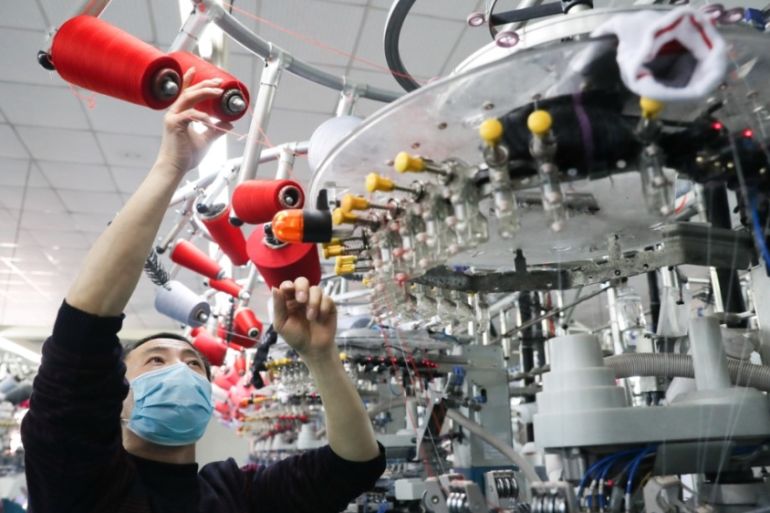Strong China factory data show domestic demand driving recovery
October data show China’s manufacturing activity accelerated to a nine-year high led by strong domestic demand, but exports lagged as US and Europe struggle with COVID-19.

China’s manufacturing activity kept up its steady expansion from a deep slump caused by the coronavirus pandemic earlier this year, new survey data show.
The main reason for the growth has been domestic demand as Chinese people spent on travel, leisure and shopping for consumer goods, helped by a long public holiday in October.
Keep reading
list of 4 itemsIndia reportedly considers Taiwan trade talks, angering China
Is China’s recovery helping Asia’s other big exporting economies?
Five questions about China’s latest five-year plan
But export activity remains weak, with analysts saying the continuing coronavirus pandemic in China’s main overseas markets of the United States and Europe is likely to suppress demand there for some time.
The Caixin China General Manufacturing Purchasing Managers’ Index (PMI) for October rose to 53.6 in October from 53 a month earlier, the sixth straight month it has stayed above the 50 mark that separates growth from contraction.
The latest figure was the highest since January 2011. It had plunged to a historic low of 40.3 in March as most of China’s economy shut down to control the spread of the coronavirus.
The Caixin survey focuses mostly on China’s smaller firms, while a similar monthly government poll takes in large state-owned enterprises.
![China official purchasing managers' index chart [Bloomberg]](/wp-content/uploads/2020/11/365687269.jpg?w=770&resize=770%2C433)
“The Caixin manufacturing PMI points to an acceleration in manufacturing activity in October. Admittedly, the official survey released on Saturday pointed to a marginal slowdown. But taken together, they suggest that momentum in the manufacturing sector remained robust last month,” Julian Evans-Pritchard, senior China economist at research firm Capital Economics said in a research note sent to Al Jazeera.
China’s economy grew by 4.9 percent in the third quarter compared with the same period in 2019, faster than a 3.2 percent growth rate in the second quarter.
The October Caixin survey exceeded analyst forecasts. Economists polled by Refinitiv before the data was released showed them expecting an index level of 53.0.
Bumps ahead?
But a breakdown of the findings revealed possible weaknesses in the months ahead.
One area of concern, analysts said, was that new export orders fell in October, pointing to a weak overseas economic recovery.
“This is likely attributed to the re-implementation of lockdown measures in Europe and the US amid new waves of COVID-19 infections,” Jingyang Chen, Greater China economist at HSBC, said in a research note sent to Al Jazeera.
Consumption has formed a growing part of China’s economy, rising from a low of 48.9 percent of gross domestic product (GDP) in 2010 to 55.1 percent in 2018, according to the World Bank.
Exports, on the other hand, have fallen in importance, from a peak of 36 percent of GDP in 2006 to 18.4 percent last year.
Meanwhile, the Caixin employment sub-index for October was only slightly above 50, posing another source of concern for economists.
Even though many companies reported a recovery in orders, they did not add more staff in an effort to keep costs down.
“This means that a jobs recovery should remain the top policy priority, as it is essential for sustained growth in household consumption and the overall services sector,” said HSBC’s Chen.
And the recovery among Chinese firms could be derailed if both overseas demand and employment remain weak, analysts said.
“Looking ahead, we expect external demand to remain weak due to the increases in COVID-19 cases in Europe and the US,” wrote Iris Pang, chief Greater China economist at Dutch bank ING.
“This will affect not only manufacturing activities in China but also employment in this sector,” Pang said in a note sent to Al Jazeera.
“A squeeze on manufacturing employment could feed through to the lower-skilled service sector, weighing on wages and reducing the spending power of the large low-income class.”